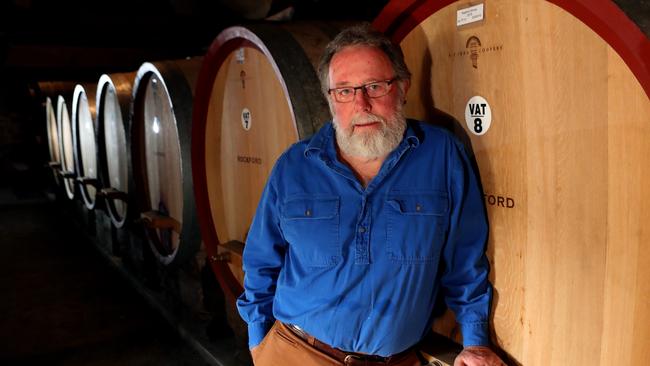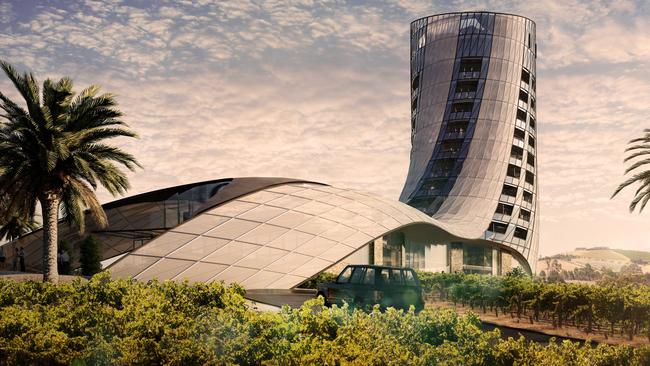The battle for the Barossa
A controversial hotel proposal for the Barossa Valley has fired up some locals who claim it will damage the wine region’s global reputation for character and authenticity.
SA Weekend
Don't miss out on the headlines from SA Weekend. Followed categories will be added to My News.
It’s a hard image to wrap your mind around, more than 30 years after the fact. Barossa Valley vineyards in flames – not because of bushfire, but the deliberate acts of those who believed the region had no future in wine.
It was a time when winemakers were paying people to take wine they could not sell. Grape growers were ripping vines out of the land and walking away from the industry because they could make more money from the state government’s “vine-pull” subsidy than by selling grapes.
Robert O’Callaghan is one of the great characters of the Barossa. And possibly one of the bravest, after starting Rockford Wines in 1984 during the valley’s nadir.
“It’s impossible, unless you were standing there watching heaps of vines burning, it’s impossible to tell people nowadays how desperate it was,’’ O’Callaghan says. “There were just heaps of vines from one end of the Barossa to the other on fire. That’s a memory you don’t forget.’’
We are sitting in his home, built by another Barossa pioneer, Johann Henschke, in the 1850s. We are talking about those dark days – and a new threat that O’Callaghan and some of his mates who revived the Barossa see to the valley.

Back in the ‘80s, he, along with fellow famous Barossa names such as winemakers Marg and Peter Lehmann, Yalumba director James Wark and food legend Maggie Beer started the Barossa Region Residents Association, an organisation that played a crucial role in building the Barossa we know today. The Barossa that is known around the world.
Now O’Callaghan, Wark, Beer and Marg Lehmann are speaking out against the $50m, 12-storey Oscar hotel that is being proposed to be built at the historic Seppeltsfield winery, and which is backed by identities including hotelier Peter Hurley and former Adelaide captain Mark Ricciuto.
The hotel, which detractors refer to as “the slug”, is currently subject of a legal battle between the winery’s neighbours, the Light council and designers Intro Architects in the Environment, Resources and Development Court.
Seppeltsfield owner Warren Randall has already threatened to take the Oscar to another wine region. Randall says the Light council only received 56 complaints about the Oscar, equivalent to 0.2 per cent of the region’s population.
Randall says the Barossa is falling behind other wine regions and needs an “absolute icon, an architectural statement’’ to attract international tourists.
“I am sick and tired of fuddy duddy developments in regional areas, we really do need bold statements of architecture to attract future tourists otherwise we are just like any other wine district in Australia,’ Randall says.

But where he sees opportunity, others see threat.
“It has the potential to do an enormous amount of damage,’’ O’Callaghan says.
“Because brand Barossa is based on quality, heritage, tradition. These are the hallmarks of the brand. This thing is the antithesis of that. This represents everything we stand against.’’
Beer has another word. Authenticity. It was at Beer’s Pheasant Farm in the ’80s that the early seeds of the Barossa Region Residents Association were sown.
There was a “Wednesday table’’ every week that she would host. It was a relaxed affair. Anywhere between six and 12 people would show up. Visitors would bring wine and Beer would cook. The Lehmanns were regulars. As was O’Callaghan and other wine industry legends such as Bob McLean and Charles Melton. But it was a bit of an open door policy. Visiting poets, singers, chefs and journalists would turn up.
The fate and the state of the Barossa was a regular topic of conversation.
“It was just pulling everyone together, and saying, ‘what are we going do about it?’ ’’ Beer says.
It was at another big event, the 40th birthday of artist Rod Schubert and Beer’s husband, Colin, that was the catalyst for the creation of the residents association. It was held at Schubert’s house and O’Callaghan, the Lehmanns and Wark were there.
Wark had been living in Melbourne but had returned to the Barossa in 1979. While living in Victoria he had been involved in a residents’ ginger group in South Melbourne and passed on his wisdom of how to run these things.
“We need to be well-funded, well-resourced and have the right people,’’ was his advice. “You can’t have people who have the right intentions but are wildly outspoken or who will antagonise the community.’’
The intention was to save the Barossa. After the wine boom of the ’70s, the industry had collapsed nationally. The Barossa was seen to be too hot, grew the wrong varieties, to not have enough water. Few winemakers put Barossa on their labels. By the mid-80s, cabernet sauvignon grapes were being turned into sweet sherry.
The 1987 Barossa vintage report painted a bleak picture. “The legacy of the Vine Pull Scheme was that the Barossa’s vine acreage was reduced by 9 per cent,’’ it says. “The greatest loss was the destruction of old Shiraz vines.’’
Still, the same report also provided hope for the future. It noted the formation of the residents association, “with Robert O’Callaghan as inaugural president and a committee including Margaret Lehmann, Helen Martin, James Wark, Tim Barritt and Lyn Leader-Elliott’’.
The association lobbied local and state governments for a strategic approach to regional planning, the retention of viticultural land and preservation of the character of the Barossa.
It persuaded then Environment and Planning Minister Susan Lenehan to halt proposed residential subdivision. Lenehan says real estate agents and property developers were circling the financially struggling grape growers, hoping to buy cheap land. “And hence, the Barossa Valley would have become another suburb of Adelaide,’’ she says.

Lenehan was shown around the Barossa by the association and decided something needed to be done. She went to California’s Napa Valley, another wine region close to a big city – San Francisco – and had grappled with development problems.
“We … met with and talked to everybody that we could and discovered what they had done to save the Napa Valley from this absolute incursion of development,’’ she says.
Lenehan was convinced. A freeze was put on new titles in lands zoned rural, a review was carried out, planning legislation was introduced and steps were taken to amalgamate the councils of the Barossa, Tanunda, Angaston and Mt Pleasant into one body. It would lead to the Barossa Valley Review Zione then the Character Preservation Act
The residents association was a force from the outset. Marg Lehmann says it had around 1500 member at its peak. The first meeting was chaired by Peter Lehmann at Tanunda’s Soldiers’ Memorial Hall.
“Membership was right across the board,’’ Lehmann says. “Growers, winemakers, medicos, all the lawyers, all the shopkeepers virtually. They all knew it was in their interest. There was a recognition that we all needed each other. The economy is an interlocking thing.’’
Another early victory was stopping the original Tanunda library from being demolished and turned into a second-hand car yard. But people still had to be convinced. O’Callaghan had to persuade grape growers to leave their vines in the ground and not accept the government’s $2400 an acre offer to pull them up.
“I can remember standing in front of Barossa growers and just passionately making my case and it was like talking to a wall of granite. There was nothing coming back. Just nothing.’’
It was a tough crowd but the growers listened, even if O’Callaghan wasn’t sure at the time. It was not until 15 years later that premium grape grower Jeff Hoffman, who sells to Rockford among others, told O’Callaghan he had gone home and ripped up his cheque after one impassioned plea.
Winemakers took their message to the world as well. And wine journalists from all over were brought to the Barossa.

Beer remembers cooking for a Lindemans dinner where 1500 glasses of wine were served.
“And these people were blown away because Barossa hospitality is really in depth, it’s real, it’s full of characters. That then made all the difference in the world to the status of the Barossa wine.’’
It is that premium status of the Barossa that they believe is under threat by the Oscar development. All agree the Barossa needs quality, luxury accommodation but believe this design is all wrong. “Within this area you have these really, really, really special areas that must be protected almost at all costs,’’ James Wark says.
“You need to try to realise how special these places are and how unique they are not just for us now but for future generations of the people who come here to see those special areas.
“I think that building is inappropriate to be put in such a precious site.’’
Wark says a more sympathetic design that fitted into the landscape would be better and references the now destroyed Southern Ocean Lodge on Kangaroo Island as a good example.
Warren Randall says many buildings loved today were opposed when they first proposed.
“The Eiffel Tower is an example. The Sydney Harbour Bridge is an example or the Sydney Opera House. The Cube (in McLaren Vale) is an example. You can’t please every one all of the time.’’
The broader concern is if the Oscar is approved then it “opens the floodgates’’ for similar developments in the Barossa.
Maggie Beer says the Barossa does not need a landmark like the d’Arenberg Cube. “Our icon is the whole of the valley,” she says. “Not everyone travelling needs glitz and glamour. What they want is authenticity and realness.’’
The battle has reinvigorated the Residents Association with a new generation taking over. President James Lindner is aiming to build it up to 500 members and says 30 Barossans have already donated more than $70,000 to help fund the legal challenge brought by Seppeltsfield’s neighbours in the Environment, Resources and Development court. At the time of printing, a decision was still pending.
Hearings were held over three days to decide whether the Oscar should be a category two or three development. On April 9 last year, new regulations under then-state planning minister and Barossa MP Stephan Knoll made it easier for tourism accommodation to be built in regional areas if valued at more than $3m.
The new regulation meant projects previously classified as category three defaulted to category two. A category two development means only immediate neighbours can lodge an objection and have no appeal rights. Category three means anyone, anywhere in the state, can object and appeal rights are preserved.
Knoll is quitting at the March election, and has since expressed doubts about the Oscar. As has potential replacement, Ashton Hurn, the new Liberal candidate. “I share the community concerns about aspects of this design and how it fits within the character of the Barossa,’’ Hurn says.
Back in Johann Henschke’s house, O’Callaghan denies he is anti-development. His is a straightforward argument. Look at the advances the Barossa has made in the past 30 years. It has emerged from the doldrums to become one of the world’s best-known wine regions – and done so by preserving its character and integrity.
“If you are saying we are anti-development you have got your brains in backwards,’’ he says. “The development (of the Barossa) that grew out of the certainty of having clear planning direction for the region was massive. Billions of dollars. So the argument that it’s anti-development is horse shit.
“We had to build a brand out of that mess and we did a phenomenal job.’’




